The Scarlet Pimpernel (1935)
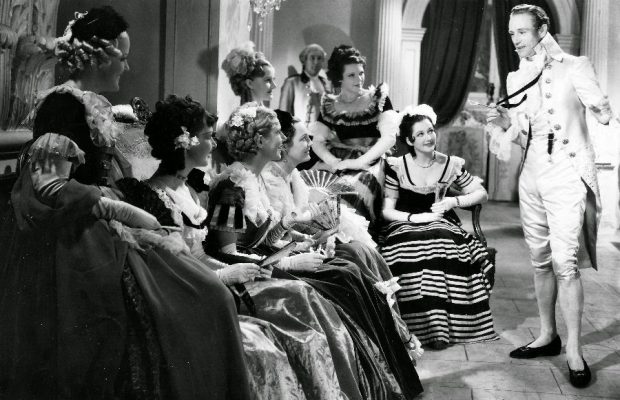
Toronto Film Society presented The Scarlet Pimpernel (1935) on Saturday, April 30, 2022 as part of the Season 74 Film Buffs Screening Series, Programme 6.
Toronto Film Society presented The Scarlet Pimpernel (1935) on Sunday, October 22, 2017 in a double bill with Sherlock Holmes and the Secret Weapon as part of the Season 70 Sunday Afternoon Film Buff Series, Programme 2.
Production Company: London Film. Producer: Alexander Korda. Director: Harold Young. Screen Play: S.N. Behrman, Robert Sherwood, Arthur Wimperis, and Lajos Biro, based on the novel by Baroness Emmuska Orczy. Cinematography: Harold Rosson. Special Effects: Ned Mann. Production Design: Vincent Korda. Film Editor: William Hornbeck. Music Score: Arthur Benjamin. Music Director: Muir Mathieson. Costumes: John Armstrong and Oliver Messel. Sound Recording: A.W. Watkins. Release Date: February 8, 1935.
Cast: Leslie Howard (Sir Percy Blakeney), Merle Oberon (Lady Marguerite Blakeney), Raymond Massey (Chauvelin), Nigel Bruce (The Prince of Wales), Branwell Fletcher (The Priest), Anthony Bushell (Sir Andrew Ffoulkes), Joan Gardner (Suzanne de Tournay), Walter Rilla (Armand St. Just).
With regard to The Scarlet Pimpernel, the author, Baroness Orczy was a member of a noble Hungarian family, born in 1865. Her parents were forced to leave Hungary in 1868 in fear of a peasant rebellion and lived in various European countries before settling in England in 1880. She tried to earn a living for herself and her husband as a writer, but had little success with her first novels until she and her husband wrote a play based on one of her stories about an apparently foppish and ineffectual English aristocrat Sir Percy Blakeney who rescues French aristocrats from the guillotine under the alias of the Scarlet Pimpernel. The play was a huge popular success with 2000 performances in London and equal success all over Europe. She followed this up with a dozen sequels featuring this character and also numerous historical novels that were enormously successful at the time but are now mostly forgotten. Tonight’s film, starring Leslie Howard, is considered the best of the series. The Pimpernel character is often thought to be the origin of dual identity characters such as Batman, Zorro and Superman.
Introduction by Graham Petrie
“Alex was Hungarian, imaginative, intelligent, extravagant.
Although lacking business sense, he had an uncanny ability to find money,
and he also had an uncommon feeling for quality.” – Raymond Massey
The “auteur” theory of film authorship may apply most often to directors, but other artists can certainly acquire the label, be they writers, actors, cinematographers, or composers. The Scarlet Pimpernel (1934), one of the great costume adventure films of its time, is the work of an auteur producer, Alexander Korda. His stamp is simply all over the movie, beginning with the script’s overall wit and humour—two qualities which were in short supply in the original source material.
The Scarlet Pimpernel began life as a 1905 play by Hungarian Baroness Emmuska Orczy and Montague Barstow. Three years later, it was novelized by Orczy as the first of a series of novels. The story is set during France’s Reign of Terror. Innocent French noblemen are being guillotined daily, but a mysterious man heroically rescues many of them, always leaving behind a small red flower—a pimpernel—as his trademark. The Scarlet Pimpernel, as he is called, is revealed to us to be Sir Percy Blakeney, a British aristocrat who pretends to be a foppish and ineffectual dandy in order to throw off suspicion. Even his disgusted French wife is unaware of his secret identity. The French, however, figure out that the Pimpernel is English and send an emissary, Chauvelin, to London to find him.
Korda originally had Charles Laughton in mind for Blakeney, but luckily he ended up with Leslie Howard, who became a huge star because of this picture. As Blakeney’s wife, he cast the beautiful Merle Oberon (who later became Mrs. Korda), and playing the villain Chauvelin was Canadian actor Raymond Massey. Two more production members, imported from America, were cinematographer Harold Rosson and editor William Hornbeck, both among the finest in Hollywood at their professions. This was a sign of Korda’s extravagance—bringing over such craftsmen was definitely not the norm for British movies at this time. Assembling the right crew, however, is one of the chief jobs of a producer, and Korda knew how to hire a winning combination of people to achieve what he wanted. In the case of The Scarlet Pimpernel, Korda wanted to fully and lavishly recreate the French Revolution, and these were the people to pull it off in style. (Both Rosson and Hornbeck stayed to work on a few more Korda pictures, as well.)
The Scarlet Pimpernel’s original director, Rowland Brown, was famously fired on just the first day of production, after butting heads with Korda. According to Raymond Massey’s autobiography, A Hundred Different Lives, Korda watched Brown direct a scene and the told him disapprovingly that he was shooting it as if it were a gangster film. Brown replied that he would direct it his way or walk out. Korda said, “Please walk,” and Brown was gone. Korda directed the scene himself and, by that afternoon, had hired a replacement, Harold Young. Korda kept Young on a tight leash, however. As Massey wrote, “The next day, Young ostensibly took over, but the direction throughout the months of shooting remained an unofficial but smooth collaboration.”
While acting in The Scarlet Pimpernel, Raymond Massey was also starring and directing the play The Shining Hour on London’s West End, following a 125-performance run on Broadway. He managed to handle both the play and the movie, even though it meant consistent 15-hour days. Korda accommodated him by providing a car and driver each day, thereby allowing Massey to catch up on sleep during the one-hour drive to and from Elstree Studios. It also helped that, during each performance of The Shining Hour, Massey ate two full hot meals on stage as part of the play itself. (In theatre circles, the play was known jokingly as “The Dining Hour.”)
“I never had such fun working in a movie as I did on The Scarlet Pimpernel,” Massey would later recall. “Of all the heavies I have played on the screen, the most wicked and the most fun to do was Chauvelin. There was a spirit in that company, a feeling of confidence, a sort of elan which I have often found in the theatre but never sensed in any other movie.”
The Scarlet Pimpernel has been a popular source for moviemakers, over the years. It was made into several silent films and remade countless more times for film and TV. Korda himself oversaw two further versions—a sequel, The Return of the Scarlet Pimpernel (1937), with a different cast, and a remake, The Elusive Pimpernel (1950), directed by Michael Powell and Emeric Pressburger. Leslie Howard directed an entertaining, modern-day version of the story in 1941, called Pimpernel Smith (also known as Mister V), in which he plays an effete academic who rescues victims of Nazi Germany.
Sources: Kulik, Karol: Alexander Korda: The Man Who Could Work Miracles, W.H. Allen, London, 1975, Slide, Anthony: Fifty Classic British Films 1932-1982, Dover Publications, New York, 1985, TCM Movie Database
Notes by Peter Poles
Spot the Canadian by Leslie Smith
Raymond Massey was born into Canada’s wealthiest family in Toronto on August 30, 1896. His great-grandfather, Daniel Massey, pioneered the farm-implement company that to this day still boasts the Massey name, despite several mergers over the generations (Massey-Harris, Massey-Harris-Ferguson, and the Massey-Ferguson subsidiary of the US firm AGCO). It remains, after so many years, the world’s largest tractor manufacturer.
Massey high-schooled at Oakville’s Appleby College before moving on to undergrad studies at the U of T, which were rudely interrupted by WWI. He joined the Royal Regiment of Canadian Artillery, returning to Canada a lieutenant in 1916 after being wounded in the battle of Mont Sorrel, Belgium. Seconded to Yale University as an army instructor for American officers, Massey would be recalled to active duty in 1918 in one of the war’s more bizarre expeditions. He joined the Canadian Siberian Expeditionary Force, a group of 4,000 soldiers who were sent with other allied units to the far reaches of Russia to combat Bolsheviks during that country’s civil war. Part of his duties was bolstering the morale of troops occupying Vladivostok. So, on orders of his commanding general, he organized a minstrel show, acting in blackface as the “end man” playing “the bones.” It was his first stage appearance.
Post-war, Massey graduated from Oxford’s Balliol College. He and his elder brother, Vincent, were slated to run the family business but both demurred. Vincent went on to become a lawyer, diplomat and, from 1952 to 1959, the first Canadian-born Governor General of Canada. Raymond began his theatrical career in London in Eugene O’Neill’s In the Zone (1922) and never looked back.
Over the next decade, he appeared in scores of plays and directed many others. He also began showing up in films, starting with the British science fiction movie High Treason (1929). Alexander Korda signed him a short while later to a five-year contract. Under Korda’s auspices, Massey took on his most famous early role, that of the sneering arch-villain Chauvelin in 1934’s The Scarlet Pimpernel. Another renowned portrayal was the pacifist hero John Cabal in Things to Come (1936). After relocating to Hollywood, Massey’s film highlights include Jonathan Brewster in Arsenic and Old Lace (1943), D.A. Frank Lalor in The Woman in the Window (1944), Joan Crawford’s husband Dean Graham in Possessed (1947), publisher Gail Wynand in The Fountainhead (1949), and Adam Trask, James Dean’s father, in East of Eden (1955).
A new World War interrupted all this activity. In 1942, Massey rejoined the Canadian Army, serving as a major in the adjutant general’s branch. After being wounded once again (two wars in a row!), Massey was permanently invalided out in 1943. In 1944, following the lead of so many other Hollywood Canucks, he became an American citizen. The decision may have been a late response to critics who lambasted casting a Canadian as America’s greatest president in a 1938 stage production of Abe Lincoln in Illinois. (The Yanks must have forgotten that Torontonian Walter Houston also played Abe Lincoln in the 1930 film of the same name, as well as a handful of other presidential figures during his illustrious career.) Rave reviews for the play silenced those voices, as did an Oscar nomination for Best Actor for the 1940 film version.
Massey went on to portray Lincoln three more times, twice on TV showcases in the 1950s and once more in 1962’s How the West Was Won. Long before Morgan Freeman came on the scene, Massey was, in his own words, “the only actor ever typecast as a president.” His obsessive preparation for his Lincoln appearances caused one friend to crack: “He won’t be satisfied until someone assassinates him.”
Massey portrayed other famous Americans, including John Wilkes Booth’s father in The Prince of Players (1955), and civil war insurgent John Brown in both Santa Fe Trail (1940) and Seven Angry Men (1955). He only once played a Canadian on-screen, appearing as Andy Brock, an ordinary serviceman, in the propaganda extravaganza 49th Parallel (1941).
Massey at one time joked, echoing a common Canadian complaint: “The British think I’m American and the Americans think I’m British.”
Post-Hollywood’s heyday, Massey gained new fame with younger audiences as Dr. Gillespie, mentor to Richard Chamberlain in the hit NBC-TV series Dr. Kildare (1961–1966), after which he basically retired. He received two stars on Hollywood’s Walk of Fame: one for his film work and the other for television.
Raymond Massey died of pneumonia in Los Angeles on July 29, 1983, the same death day as David Niven, his co-star in 1937’s The Prisoner of Zenda and 1946’s Stairway to Heaven (aka A Matter of Life and Death). Massey is buried in New Haven, Connecticut’s Beaverdale Memorial Park.
One fascinating story about Massey’s life had nothing to do with acting: After divorcing his first wife, Margery Fremantle, with whom he had one child, architect Geoffrey Massey, he wed actress Adrianne Allen, a marriage that resulted in two more children, actors Anna and Daniel Massey. Raymond and Adrianne filed for divorce in 1939 and were represented by husband-and-wife lawyers Dorothy and William Dwight Whitney, with Dorothy championing Raymond and William supporting Adrianne. When the trial was over, the Whitneys promptly divorced. William then married Adrianne, Raymond wed Dorothy, and they all lived happily ever after. Their sensational case inspired Garson Kanin and Ruth Gordon’s script for Adam’s Rib (1949).
*************
Evan Thomas plays an uncredited member of the Scarlet Pimpernel league. Born February 17th, 1891, in Vancouver, British Columbia, Thomas moved to Hollywood in 1930 before relocating to England, where he spent the rest of his life character-acting in small film and theatrical parts. One notable role saw him back filming in the States, cast as a commanding officer in C.B. DeMille’s unintentionally hysterical salute to Canada’s national force: North West Mounted Police (1940). Thomas died in 1982 and is buried in Tunbridge Wells, Kent.
*************
Like Raymond Massey, The Scarlet Pimpernel’s cameraman Osmond Borradaile was a Canadian veteran of both world wars. Born in Winnipeg on July 17th, 1898, Borradaile spent his childhood years in Alberta. He saw his first movie at the age of seven, in Medicine Hat.
Once of age, Borradaile moved to Hollywood and broke into the film business as a “camera grinder,” working with such legends as Lillian Gish, Rudolph Valentino and Gloria Swanson. His credits in the talkie era include several C.B. DeMille films and the aerial sequences in Howard Hughes’ Hell’s Angels (1930) – shot from a plane piloted by Hughes himself.
Borradaile began specializing in stock footage and filmed backdrops for process photography. It was a career that often entailed working in the world’s most exotic and inaccessible areas, everywhere from the jungles of the Indian sub-continent (for 1938’s The Drum, starring Sabu and Raymond Massey) to the ice floes of the South Pole (for 1948’s Scott of the Antarctic). His film work in Sudan for The Four Feathers (1939) earned an Academy Award nomination for Best Colour Cinematography.
By the mid-20th Century, Borradaile had moved back to Canada, where he continued shooting and directing films – most notably, 1958’s The Tall Country, a salute to British Columbia’s centennial, commissioned by the provincial government. It received a Canadian Film Award for Best Theatrical Short Film the following year. He also wrote his autobiography: Life Through a Lens (2001). In 1982, he was made an Officer of the Order of Canada, Canada’s highest civilian honour.
Borradaile died in Vancouver on March 23, 1999 at the age of 100.

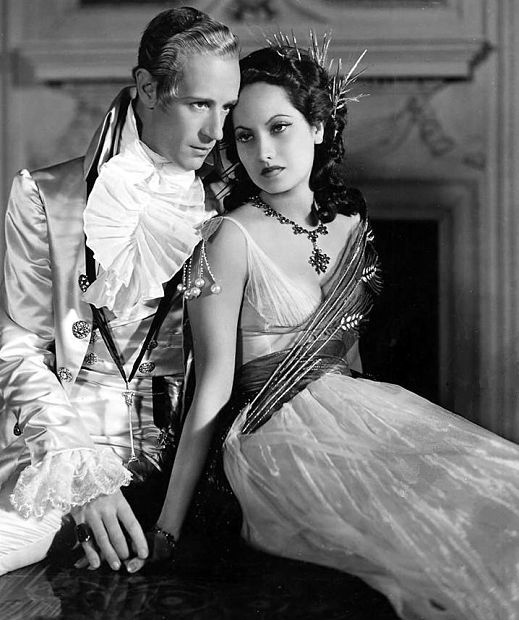
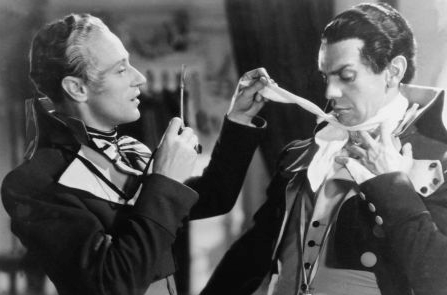
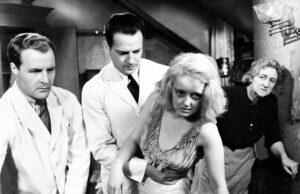
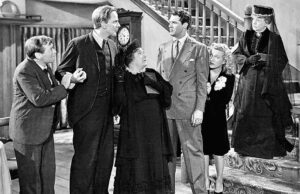
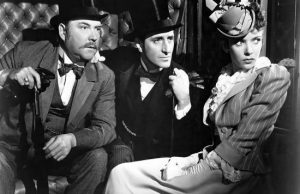






[…] (1946), Sherlock Holmes and the Secret Weapon (1942), The Strange Love of Marth Ivers (1946), The Scarlet Pimpernel […]